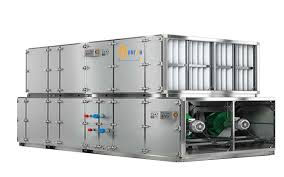Air Handling Unit, The Hidden Mechanics Behind Clean and Conditioned Air
- cyruscrafts shop
- Jul 14
- 3 min read
In the modern built environment, indoor air quality is more than a comfort issue—it's a fundamental aspect of human health, productivity, and environmental control. Whether it’s a hospital, office building, school, or shopping center, the ability to control temperature, humidity, and airborne contaminants determines how effectively a space supports its occupants.
To achieve this level of environmental precision, engineers rely on a variety of systems and technologies working behind the scenes. One of the most essential yet often overlooked components in this process is the Air Handling Unit, a critical part of centralized HVAC systems that plays a vital role in conditioning and distributing indoor air.
What Is an Air Handling Unit?
An Air Handling Unit (AHU) is a large metal box containing several key elements such as fans, filters, heating and/or cooling coils, humidifiers, and dampers. It serves as the central hub where outdoor and recirculated air is conditioned—filtered, heated, cooled, or humidified—and then pushed through a network of ducts into various parts of a building.
AHUs are typically installed in mechanical rooms, rooftops, or basements, and come in a wide range of sizes and configurations depending on the building’s needs. In essence, the AHU ensures that air entering occupied spaces is clean, at a comfortable temperature, and adequately ventilated.
The Functionality Behind the Box
Despite its simple appearance, an AHU is a sophisticated system that orchestrates several complex processes:
Filtration: Incoming air passes through one or more filters to remove dust, allergens, bacteria, and other airborne particles.
Thermal Conditioning: Depending on the season, air is either heated or cooled using coils supplied by boilers or chillers.
Humidity Control: Humidifiers or dehumidifiers adjust the moisture content of the air for comfort and process requirements.
Air Movement: High-efficiency fans drive the conditioned air into the duct system for distribution throughout the building.
Ventilation Mixing: AHUs regulate the mix between outdoor air and recirculated indoor air to maintain fresh air supply without energy waste.
The coordinated function of these components not only creates a comfortable indoor climate but also helps meet health and safety standards such as ASHRAE and LEED certification requirements.
Types of AHUs and Their Applications
Air handling units come in several configurations, each suited for specific architectural and operational needs:
Single-Zone AHUs: Ideal for buildings with uniform heating/cooling needs across all rooms.
Multi-Zone AHUs: Designed for large buildings with varying climate demands in different areas.
Rooftop Units (RTUs): Packaged AHUs designed for outdoor installation, commonly seen in commercial buildings.
Custom-Built AHUs: Tailored for specialized applications like cleanrooms, data centers, or pharmaceutical facilities.
In all cases, proper sizing and selection are critical to avoid underperformance or energy inefficiency.
Integration with Building Management Systems
Today’s AHUs are not standalone devices; they’re part of larger intelligent systems. Modern units are equipped with sensors and control panels that allow them to communicate with Building Management Systems (BMS). These integrations enable:
Automated Air Quality Monitoring
Real-time Energy Optimization
Predictive Maintenance Alerts
Demand-Based Ventilation Adjustments
Such connectivity is essential for smart buildings, where energy efficiency and occupant wellbeing are closely monitored and adjusted dynamically.
Energy Efficiency and Sustainability
Because AHUs operate continuously in most commercial settings, their energy footprint can be significant. However, recent innovations have introduced several features to minimize energy use:
ECM (Electronically Commutated Motor) Fans: Provide variable-speed control with lower power consumption.
Heat Recovery Systems: Capture and reuse energy from exhaust air to precondition incoming air.
Demand-Controlled Ventilation: Uses CO₂ sensors to adjust airflow based on occupancy levels.
By implementing high-efficiency AHUs with these features, building owners can significantly reduce utility costs and carbon emissions, while maintaining indoor comfort.
Maintenance and Lifecycle Considerations
Like any mechanical equipment, AHUs require regular maintenance to operate effectively. Filters must be replaced periodically, fans and motors need inspection and lubrication, and coils must be kept clean to prevent energy loss and microbial growth.
Neglecting AHU maintenance can result in poor air quality, higher operating costs, and even health risks due to mold or bacteria buildup in the ducts. Establishing a proactive maintenance schedule helps extend the lifespan of the unit and protect both occupants and equipment.
Conclusion
As buildings grow more complex and energy-conscious, the systems responsible for indoor air conditioning and ventilation must evolve accordingly. The Air Handling Unit remains a cornerstone of modern HVAC design—quietly powering the delivery of clean, comfortable, and safe air to people in all kinds of indoor spaces.
Far from being just a mechanical box in a basement or on a roof, the AHU is a dynamic, adaptive tool at the heart of sustainable and intelligent building environments. By understanding its role and optimizing its design, we can improve not only energy performance but also the daily experiences of everyone who lives, works, and breathes inside our built spaces.



Welcome to Kelvin Mech – a leading name in heating, ventilation, and air conditioning solutions across the country. With a strong presence as an established HVAC contractor in Mumbai, Delhi, and Pune, we specialize in offering customized HVAC design, installation, and maintenance services for commercial, industrial, and residential projects.